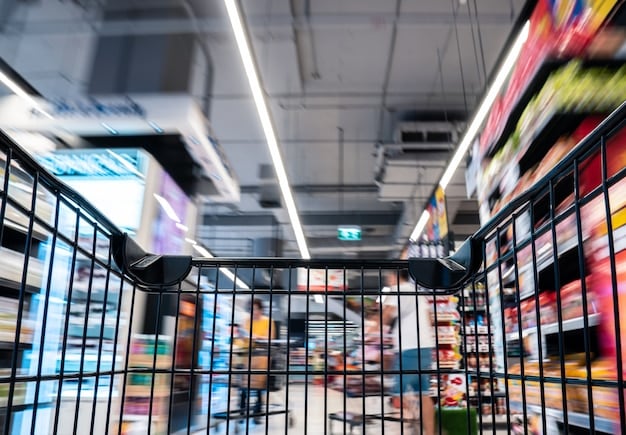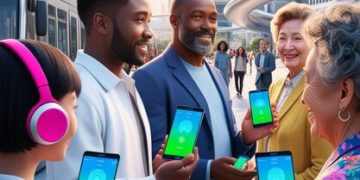Top 5 Retail Trends Shaping US Business in the Next 6 Months

Alert: The Top 5 Business Trends Shaping the US Retail Sector in the Next 6 Months include the rise of personalized shopping experiences, the integration of augmented reality (AR) in retail, the increasing importance of sustainable practices, the expansion of buy now, pay later (BNPL) options, and the growing adoption of contactless payment methods.
Get ready for a retail revolution! This article unveils the top 5 business trends shaping the US retail sector in the next 6 months, providing crucial insights for businesses and consumers alike.
The Rise of Personalized Shopping Experiences
Personalization is no longer a luxury; it’s an expectation. In the competitive US retail landscape, understanding and catering to individual customer preferences is paramount for success.
Retailers are increasingly leveraging data analytics, artificial intelligence (AI), and machine learning (ML) to create tailored experiences. This involves everything from personalized product recommendations to customized marketing campaigns.
Data-Driven Customization
Data is the cornerstone of personalization. By collecting and analyzing customer data, retailers can gain valuable insights into buying habits, preferences, and demographics.
AI-Powered Recommendations
AI algorithms can analyze vast amounts of data to predict what customers are likely to buy, leading to more relevant product recommendations and targeted advertising.
- Providing customized product recommendations based on past purchases and browsing history.
- Sending personalized email marketing campaigns with offers tailored to individual customer preferences.
- Offering unique shopping experiences based on location data and real-time customer behavior.
These personalized experiences not only enhance customer satisfaction but also drive sales and foster brand loyalty. Retailers that embrace personalization are better positioned to thrive in the evolving retail landscape.
Augmented Reality (AR) in Retail: A Game Changer
Augmented reality (AR) is transforming the way consumers interact with products and brands. By overlaying digital content onto the real world, AR offers immersive and engaging shopping experiences.
From virtual try-on tools to interactive product displays, AR is revolutionizing the retail sector. The technology allows shoppers to visualize how products would look in their homes or on themselves, enhancing the buying process.

Virtual Try-On Tools
AR-powered virtual try-on tools allow customers to see how clothing, accessories, and cosmetics look on them without physically trying them on.
Interactive Product Displays
AR can transform static product displays into interactive experiences, providing customers with additional information and engaging content.
- Allowing customers to virtually place furniture in their homes to see how it fits with their décor.
- Offering virtual try-on experiences for clothing and accessories, eliminating the need for physical fitting rooms.
- Creating interactive product displays that provide detailed information and engaging content through a smartphone app.
As AR technology becomes more accessible and sophisticated, expect to see even more innovative applications in the retail sector. Retailers who adopt AR early will gain a competitive edge and attract digitally savvy consumers.
Sustainability: A Core Value for US Retail Consumers
Sustainability is no longer a niche trend; it’s a core value for many US retail consumers. Customers are increasingly seeking out brands that prioritize environmental responsibility and ethical sourcing.
Retailers are responding by implementing sustainable practices throughout their supply chains, from sourcing eco-friendly materials to reducing waste and carbon emissions.
Eco-Friendly Materials
Using sustainable materials such as organic cotton, recycled polyester, and bamboo helps reduce the environmental impact of retail products.
Reducing Waste and Emissions
Implementing practices to minimize waste, conserve energy, and reduce carbon emissions is crucial for creating a sustainable retail operation.

- Partnering with suppliers who share a commitment to ethical and sustainable practices.
- Offering products made from recycled and renewable materials, reducing reliance on virgin resources.
- Implementing energy-efficient technologies in stores and distribution centers to minimize carbon emissions.
For retailers targeting millennial and Gen Z consumers, sustainability is non-negotiable. Brands that authentically embrace sustainability will build stronger connections with their customers and drive long-term growth.
Buy Now, Pay Later (BNPL): Increasing Spending Power
Buy Now, Pay Later (BNPL) services have exploded in popularity, offering consumers a flexible way to finance their purchases. This trend is especially prevalent in the US retail sector, where consumers are increasingly seeking out convenient payment options.
BNPL allows customers to split their purchases into smaller, more manageable payments, often without incurring interest or fees. This makes it easier for consumers to afford higher-priced items and encourages impulse buying.
Flexible Payment Plans
BNPL providers offer a variety of payment plans, allowing customers to choose the option that best fits their budget and financial needs.
Increased Purchasing Power
By spreading out payments over time, BNPL services increase consumers’ purchasing power and enable them to buy more products.
- Promoting BNPL options at the point of sale to encourage customers to make larger purchases.
- Partnering with multiple BNPL providers to offer a variety of payment options.
- Integrating BNPL services seamlessly into the online and in-store shopping experience.
While BNPL can be a valuable tool for consumers, it’s essential to use it responsibly. Retailers should educate their customers about the terms and conditions of BNPL agreements and encourage them to borrow responsibly.
Contactless Payments: Convenience and Safety First
The adoption of contactless payment methods has accelerated in recent years, driven by a desire for convenience, safety, and hygiene. In the wake of the COVID-19 pandemic, consumers are increasingly avoiding physical contact with payment terminals.
Contactless payments include mobile wallets like Apple Pay and Google Pay, as well as contactless credit and debit cards. These methods allow customers to complete transactions by simply tapping their device or card on a payment terminal.
Enhanced Security
Contactless payments employ encryption and tokenization technologies to protect sensitive payment information, reducing the risk of fraud.
Faster Transactions
Contactless payments are typically faster than traditional payment methods, reducing checkout times and improving the overall shopping experience.
- Upgrading payment terminals to accept contactless payments.
- Promoting contactless payment options through signage and marketing materials.
- Training staff on how to process contactless payments quickly and efficiently.
Retailers that offer contactless payment options are better positioned to attract customers who value convenience and safety. Contactless payments are likely to remain a dominant trend in the retail sector for the foreseeable future.
Embracing the Metaverse for Retail
While still in its nascent stages, the metaverse presents a unique and potentially lucrative opportunity for retailers to engage with customers in a virtual world. This digital frontier offers entirely new avenues for branding, product promotion, and customer interaction.
Retailers can create virtual stores within metaverse platforms, allowing customers to browse and purchase products in a 3D environment. They can also offer virtual experiences, such as fashion shows, product demonstrations, and personalized shopping consultations.
Virtual Storefronts
Building virtual stores in the metaverse replicates the in-store shopping experience online, but now in a completely immersed and personalized 3D format.
NFTs and Digital Assets
Retailers can leverage NFTs (Non-Fungible Tokens) to offer exclusive digital products, loyalty rewards, and collectible items within the metaverse.
- Collaborating with metaverse platforms to establish a virtual retail presence.
- Offering virtual versions of physical products for purchase and use within the metaverse.
- Creating gamified shopping experiences to incentivize engagement and reward customer loyalty.
The metaverse is still evolving, but its potential to transform the retail sector is undeniable. Businesses that experiment with metaverse technologies and strategies are likely to gain a competitive advantage in the years to come.
| Key Trend | Brief Description |
|---|---|
| 🛍️ Personalized Shopping | Tailoring shopping experiences to individual customer preferences. |
| 👓 Augmented Reality (AR) | Integrating AR for virtual try-ons and interactive displays. |
| 🌎 Sustainability | Prioritizing eco-friendly materials and ethical practices. |
| 💳 BNPL | Offering “Buy Now, Pay Later” options for flexible payments. |
FAQ
▼
Personalized shopping involves tailoring the shopping experience to individual customer preferences using data, AI, and machine learning to provide relevant product recommendations and targeted marketing campaigns.
▼
Augmented reality enhances the retail experience by overlaying digital content onto the real world, allowing customers to virtually try on products, visualize items in their homes, and interact with products in new ways.
▼
Sustainability is important because consumers are increasingly seeking out brands that prioritize environmental responsibility and ethical sourcing, making it a core value for many US retail customers.
▼
BNPL services allow customers to split their purchases into smaller, more manageable payments, often without incurring interest or fees, making it easier for consumers to afford higher-priced items.
▼
Contactless payments offer convenience, safety, and hygiene by allowing customers to complete transactions by simply tapping their device or card on a payment terminal, reducing checkout times and improving overall security.
Conclusion
The US retail sector is undergoing rapid transformation, driven by technological advancements, evolving consumer preferences, and a growing emphasis on sustainability. By embracing these top 5 business trends, retailers can position themselves for success in the months to come, creating enhanced customer experiences and driving growth in a competitive market.





